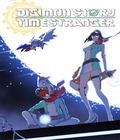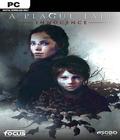Unless you're playing Ratatouille, the rat is considered to be the most basic of video game enemies. They are commonplace in most video games, especially dungeon-crawlers and RPGs. Their squeaks are unmistakable, and while they can be hurt, they're merely used as starter enemies and fodder to help players get their feet wet for combat before moving on to more formidable adversaries. All of the marketing for A Plague Tale: Innocence, however, paints the rodents in a different light. The rats are now made out to be creatures with immense killing power in a swarm and the most frightening thing possible. That depiction certainly piques a player's interest, and luckily, the curiosity is well rewarded.
The story takes place in 1348, the early years of both The Hundred Years War and the bubonic plague. Players take on the role of Amicia de Rune, daughter of a famous French knight; your little brother Hugo is suffering from an unknown malady. One day, while you're in the forest, you see your faithful dog being devoured by an unknown force. You return home, but it doesn't take long before the Inquisition comes by to murder just about everyone in your household. You rescue your brother Hugo, and as new orphans, you both race to find a cure for your brother's disease while also trying to escape capture from those who want your brother for mysterious reasons.
The story is one of the main hooks of A Plague Tale, and it is told quite brilliantly. The pace is measured just right, so elements don't feel rushed, and some decisions are thoughtful rather than careless. The story also benefits from some very nice characters. Some of the allies you find along your journey feel fleshed out, even if they don't interact with you that much, and only the villains feel one-dimensional. The sibling duo's relationship also comes off as realistic when you consider their age difference and backgrounds. Some of the things that Hugo does can be infuriating, though. Even with the understanding that he's only five years old, you'll want to give him a good whack when he pitches a temper tantrum about wanting to see his mother as you're trying to hide from villagers.
Before talking about the gameplay mechanics, the elephant in the room should be addressed first. If you've seen any footage or pictures of the game prior to its release, then you'll have surmised that A Plague Tale is essentially one giant escort mission, and that's partially true. You're always holding Hugo's hand, but at least that's done with a toggle instead of constantly holding down a button. Climbing up ladders and jumping up ledges means that he has to go first before you can. You can separate from him, but if you go too far, he gets a panic attack, which ruins your stealth and attracts the guards' attention. There are a few instances where you need him to crawl through holes to open doors and gates from the other side, but Hugo's usefulness usually stops there.
While escort missions are usually a deal breaker for most players, the game does a lot of things well to nullify concerns that people might have about this mechanic. For starters, Hugo's running pace keeps up with yours, so he doesn't slow you down when you're holding on to him. None of the ladder or ledge sequences put you in immediate danger with enemies, and the same goes for his headaches, which only occur in safe areas. His AI is good enough that he'll crouch when you do, and he doesn't wander off and get eaten by rats. On the off chance that he or any other companion gets attacked, the game provides an ample amount of time to react and save the situation. You don't have to let go of him when you need to attack, so he can tag along in a fight. Overall, his ability to stay out of the way means you won't mind having him around.
The gameplay is split pretty evenly between stealth and environmental puzzles, with a good amount of chase and exploration sequences to keep things varied. The stealth is fairly basic, so hiding behind things will be good enough, but you still need to be wary about making too much noise or figuring out where an enemy's gaze would be. Distracting guards can be done by throwing rocks at metal objects, and the game's generous auto-aim and color change make it easy to know if you'll hit your target. Failing that, you can throw pots to distract guards, and the indicator does a great job of letting you know who will be affected by the breaking ceramic.
You have one weapon in your possession — a sling — that is initially needed to free objects that are tied down, and it proves to be very useful against rats because you can knock down corpses and meat so they can flock to it. The sling is also a good weapon against guards, but the noise it makes and its windup time mean that it isn't useful when a guard is right on you. You can find upgrade benches throughout the game, and if you have the necessary ingredients, you can do things like deaden the noise of your sling, increase your ammo count, and speed up your windup time. You can also craft different ammo types in the field over time, and that'll allow you to do things like knock off helmets, put out torches, or knock out a guard up close.
A Plague Tale has its fair share of lever puzzles, but they all feel logical and satisfying. There are only a few cases where you'll need to figure out how to pull levers in the correct order to open passages. Some of the puzzles involve notifying others about the appropriate time to rotate a wheel or let it go. In puzzles that involve rats, you'll either be clearing out a path of safety or distracting them to buy yourself time between light sources. Some puzzles are time-based in that your stick only lasts for a short time, so you need find a more sustainable source of light. A few puzzles are modified chase sequences, where you need to light things on the fly since the source doesn't stay lit forever. Later, on you'll find more focused lights, so you can shine a beam to drive rats in one direction. Just as in the stealth sequences, you can craft new ammo to light up things from afar, drive rats to a source for a short amount of time, or save yourself from being eaten with a well-timed explosion of fire.
Each of the gameplay mechanics is satisfying on its own, and they do very well when blended together. It's satisfying to pick off enemies one by one or sneak around a room full of guards without any deaths or detections. Moving around swarms of rats with various lights is enjoyable, if only to see them scamper about. Using those same tools to make rats eat enemies is powerful, and it doesn't get old, no matter how many times you accomplish it. Even in the late game, you're introduced to new mechanics that make you want to experiment with enemy disposal to the point where dying isn't so bad, especially with the game providing fast load times between deaths and an ample number of checkpoints for the each of the game's 17 chapters.
There are a few issues with A Plague Tale, but nothing would be considered game-breaking. While the title does a great job of letting you craft different sling ammo on the fly, it's quite difficult to actually upgrade your equipment. You'll find every element you need for the upgrades, and you'll even find yourself not being able to pick up a few because you've reached your limit. However, there are very few toolkits, which are the one universal ingredient needed for upgrades, so you'll never be able to have a fully kitted-out Amicia. Also, while almost all of the segments have a good pace, one toward the end of the game is paced poorly. Without giving away anything, the sequence is slow, the designated safe zone has too loose of a boundary, and dying means having to restart the sequence from the beginning. Considering how often death will occur, this ends up being the only truly frustrating segment of the game.
Graphically, A Plague Tale looks quite nice, even if it's all meant to be dreary. The plague-ridden hamlets and towns look ghastly and run-down, and the battlefields of corpses can be sobering to see, but the vast amounts of vegetation make things look rich nonetheless. The lighting effects are well done, which is the most important part to get right considering their important role in the game. The way the lights and shadows bounce around in both indoor and outdoor environments never fails to impress. Particle effects are also done well, but the animations and character models are most striking. Even the minor characters get a great deal of detail that is normally afforded only to the major players, so roaming guards and priests — whether standing still or in motion — look just as good as the main protagonists. The rat hordes are especially remarkable, since their movement as a horde looks so unsettling. Seeing each individual rodent run on top of one another as a giant mass is a real technical feat, and seeing them all swarm on a fresh corpse or anyone not surrounded by light will always feel unsettling.
For the most part, the sound is excellent. The music is appropriately moody, with the title screen evoking a sense that the journey is going to be sad. The other tracks elicit a sense of foreboding, with rarely a happy moment in sight. The effects all sound nice, and you'll grow accustomed to the constant screeching of the rats since you'll hear it quite often throughout the game. The voice cast performs its job well, especially the two main protagonists, who are voiced by actual children, but you'll have to come to grips with a few things. While you can select a different language, most players will stick with English, so it's charming to hear almost everyone speak English with a French accent. It's also interesting to hear some characters curse with British words, so it's odd to hear a few people call out something as "bloody."
A Plague Tale: Innocence is a pleasant surprise during a season that usually has few significant releases. The story starts off in a fascinating way, and despite a few bumps along the way, the game maintains a player's curiosity throughout its runtime. The mechanics are great, especially since the title doesn't have many of the expected drawbacks, and it's all reinforced by an excellent all-around presentation. For those who want a rich story and strong gameplay, A Plague Tale is definitely worth checking out.
Score: 8.5/10
More articles about A Plague Tale: Innocence











 A Plague Tale: Innocence offers an adventure supported by an original scenario, with gameplay that blends action, adventure and stealth phases.
A Plague Tale: Innocence offers an adventure supported by an original scenario, with gameplay that blends action, adventure and stealth phases.


























